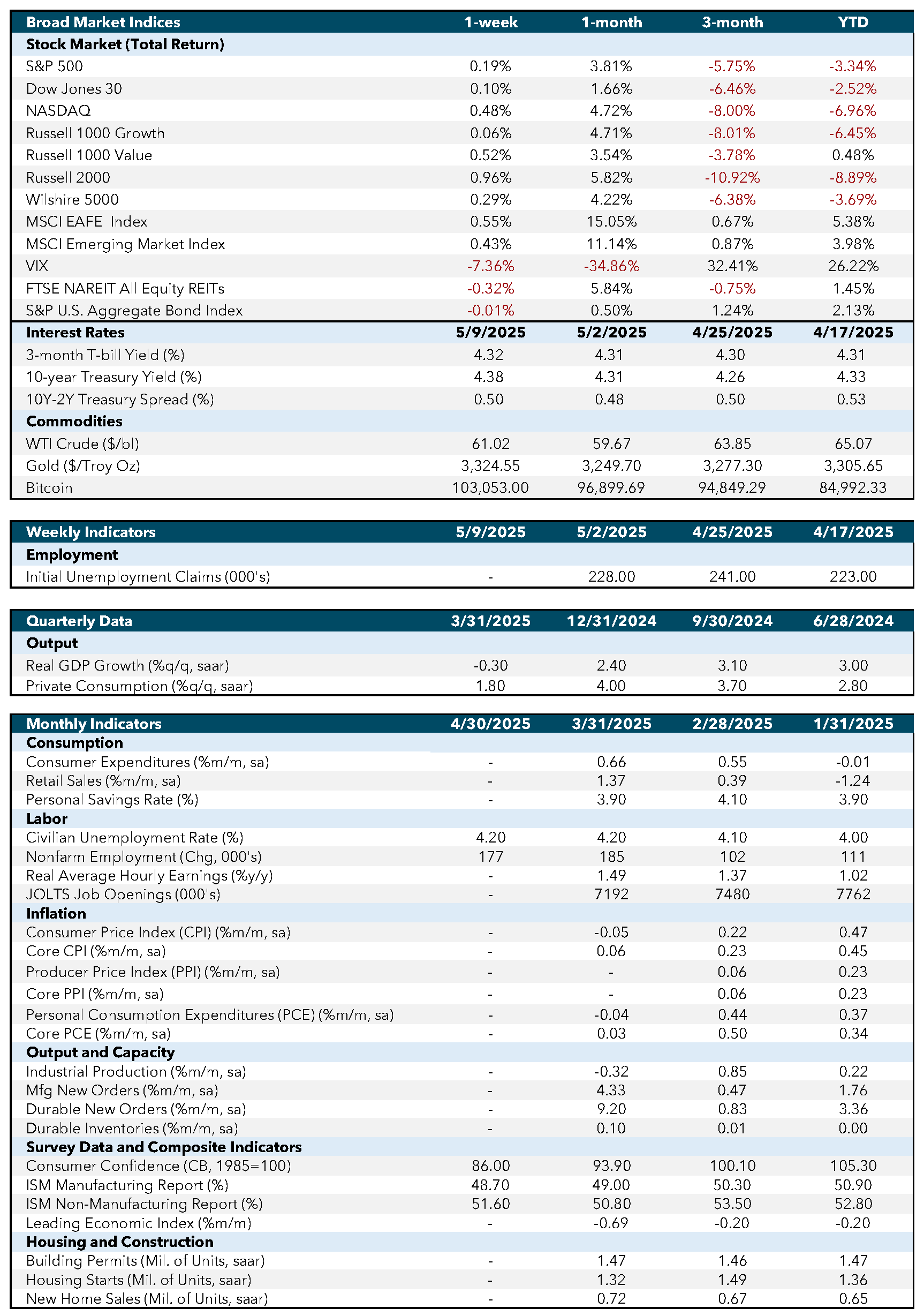Weekly Market Commentary
May 12th, 2025
Week in Review…
Last week was pivotal for market analysts, despite the lower volume of reports. The week was front-loaded with significant data providing crucial insights into various market sectors.
The biggest headline was the Federal Reserve’s decision to keep the federal funds rate at 4.25% to 4.5%, as expected. Despite solid economic activity and a stable labor market, inflation remains above the Fed’s 2% target. The Fed continues to be data-dependent and cautious, closely monitoring the risks of higher unemployment and inflation. It also confirmed the continued reduction of its Treasury securities and agency debt holdings.
Several noteworthy reports on employment and inflation were released. Thursday’s Q1 2025 Nonfarm Productivity report, measuring labor efficiency, fell short of expectations at -0.8% versus an expected -0.4%, significantly below the prior quarter’s 1.7%. The Unit Labor Costs report indicated increasing inflation pressures, with a 5.7% quarter-over-quarter rise compared to the previous quarter’s 2.0%. Together, these reports highlight the growing inflationary pressures within the economy.
Despite these disappointing numbers, the labor market showed strength with both Continuing Jobless Claims and Initial Jobless Claims beating expectations. This trend was supported by the prior week’s Nonfarm payroll numbers. The 3-year and 10-year Notes auctions provided further insight into the bond market’s view of inflation. Three-year yields increased, indicating higher inflation expectations, while the 10-year Treasury yield decreased, suggesting this trend may not persist long-term.
Finally, ISM Non-Manufacturing data released on Monday showed higher-than-expected employment and Purchasing Managers’ Index (PMI) sentiment data points. However, Non-Manufacturing Prices data reflected growing inflationary pressures. As these reports illustrate, inflation remains a central concern, influencing both market expectations and Federal Reserve policies.
Week Ahead…

This week promises to be significant as inflation takes center stage. Two major inflation reports are set for release — on Tuesday, the U.S. Bureau of Labor Statistics will unveil the Headline and Core Consumer Price Index (CPI) month-over-month numbers for April, followed by the Headline and Core Producer Price Index (PPI) on Thursday. Markets will be observing these figures to assess the impact, if any, that tariffs have had.
Continuing the inflation trend, Friday’s Michigan 1- and 5-year Inflation Expectation will gauge the percentage that consumers anticipate the price of goods and services to change over the next one and five years. Although preliminary, these reports will provide valuable insights into potential future price movements. Collectively, these reports will offer a snapshot of economic health and potential inflationary trends.
In addition to inflation data, the markets will receive several key indicators related to the real economy. On Thursday, Headline and Core Retail Sales will be released, serving as a crucial measures of consumer spending, which constitutes a significant portion of U.S. GDP. The same day will also see the release of Industrial Production and Business Inventory data, offering deeper insights into the dynamics of the business sector. Friday will provide a closer look at the housing market with the release of the Building Permits report and Housing Starts, both of which will reflect builders’ confidence levels.
Economic Indicators:
- CPI: Consumer Price Index measures the average change in prices paid by consumers for goods and services over time. Source: Bureau of Labor Statistics.
- Core CPI: Core Consumer Price Index excludes food and energy prices to provide a clearer picture of long-term inflation trends. Source: Bureau of Labor Statistics.
- PPI: Producer Price Index measures the average change in selling prices received by domestic producers for their output. Source: Bureau of Labor Statistics.
- Core PPI: Core Producer Price Index excludes food and energy prices to provide a clearer picture of long-term inflation trends. Source: Bureau of Labor Statistics.
- PCE: Personal Consumption Expenditures measure the average change in prices paid by consumers for goods and services. Source: Bureau of Economic Analysis.
- Core PCE: Core Personal Consumption Expenditures exclude food and energy prices to provide a clearer picture of long-term inflation trends. Source: Bureau of Economic Analysis.
- Industrial Production: Measures the output of the industrial sector, including manufacturing, mining, and utilities. Source: Federal Reserve.
- Mfg New Orders: Measures the value of new orders placed with manufacturers for durable and non-durable goods. Source: Census Bureau.
- Durable New Orders: Measures the value of new orders placed with manufacturers of durable goods. Source: Census Bureau.
- Durable Inventories: Measures the value of inventories held by manufacturers for durable goods. Source: Census Bureau.
- Consumer Confidence (CB, 1985=100): Measures the degree of optimism that consumers feel about the overall state of the economy and their personal financial situation. Source: Conference Board.
- ISM Manufacturing Report: Measures the economic health of the manufacturing sector based on surveys of purchasing managers. Source: Institute for Supply Management.
- ISM Non-Manufacturing Report: Measures the economic health of the non-manufacturing sector based on surveys of purchasing managers. Source: Institute for Supply Management.
- Leading Economic Index: Measures overall economic activity and predicts future economic trends. Source: Conference Board.
- Building Permits (Mil. of Units, saar): Measures the number of new residential building permits issued. Source: Census Bureau.
- Housing Starts (Mil. of Units, saar): Measures the number of new residential construction projects that have begun. Source: Census Bureau.
- New Home Sales (Mil. of Units, saar): Measures the number of newly constructed homes sold. Source: Census Bureau.
- SA: Seasonally adjusted.
- SAAR: Seasonally adjusted annual rate.
Market Indices & Indicators:
- S&P 500: A market-capitalization-weighted index of 500 leading publicly traded companies in the U.S., widely regarded as one of the best gauges of large U.S. stocks and the stock market overall.
- Dow Jones 30: Also known as the Dow Jones Industrial Average, it tracks the share price performance of 30 large, publicly traded U.S. companies, serving as a barometer of the stock market and economy.
- NASDAQ: The world’s first electronic stock exchange, primarily listing technology giants and operating 29 markets globally.
- Russell 1000 Growth: Measures the performance of large-cap growth segment of the U.S. equity universe, including companies with higher price-to-book ratios and growth metrics.
- Russell 1000 Value: Measures the performance of large-cap value segment of the U.S. equity universe, including companies with lower price-to-book ratios and growth metrics.
- Russell 2000: A market index composed of 2,000 small-cap companies, widely used as a benchmark for small-cap mutual funds.
- Wilshire 5000: A market-capitalization-weighted index capturing the performance of all American stocks actively traded in the U.S., representing the broadest measure of the U.S. stock market.
- MSCI EAFE Index: An equity index capturing large and mid-cap representation across developed markets countries around the world, excluding the U.S. and Canada.
- MSCI Emerging Market Index: Captures large and mid-cap representation across emerging markets countries, covering approximately 85% of the free float-adjusted market capitalization in each country.
- VIX: The CBOE Volatility Index measures the market’s expectations for volatility over the coming 30 days, often referred to as the “fear gauge.”
- FTSE NAREIT All Equity REITs: Measures the performance of all publicly traded equity real estate investment trusts (REITs) listed in the U.S., excluding mortgage REITs.
- S&P U.S. Aggregate Bond Index: Represents the performance of the U.S. investment-grade bond market, including government, corporate, mortgage-backed, and asset-backed securities.
- 3-Month T-bill Yield (%): The yield on U.S. Treasury bills with a maturity of three months, reflecting short-term interest rates.
- 10-Year Treasury Yield (%): The yield on U.S. Treasury bonds with a maturity of ten years, reflecting long-term interest rates.
- 10Y-2Y Treasury Spread (%): The difference between the yields on 10-year and 2-year U.S. Treasury bonds, often used as an indicator of economic expectations.
- WTI Crude ($/bl): The price per barrel of West Texas Intermediate crude oil, a benchmark for U.S. oil prices.
- Gold ($/Troy Oz): The price per troy ounce of gold, a standard measure for gold prices.
- Bitcoin: A decentralized digital currency without a central bank or single administrator, which can be sent from user to user on the peer-to-peer bitcoin network.
This content was developed by Cambridge from sources believed to be reliable. This content is provided for informational purposes only and should not be construed or acted upon as individualized investment advice. It should not be considered a recommendation or solicitation. Information is subject to change. Any forward-looking statements are based on assumptions, may not materialize, and are subject to revision without notice. The information in this material is not intended as tax or legal advice.
Investing involves risk. Depending on the different types of investments there may be varying degrees of risk. Socially responsible investing does not guarantee any amount of success. Clients and prospective clients should be prepared to bear investment loss including loss of original principal. Indices mentioned are unmanaged and cannot be invested into directly. Past performance is not a guarantee of future results.
The Dow Jones Industrial Average (DJIA) is a price-weighted index composed of 30 widely traded blue-chip U.S. common stocks. The S&P 500 is a market-cap weighted index composed of the common stocks of 500 leading companies in leading industries of the U.S. economy. The NASDAQ Composite Index is a market-value weighted index of all common stocks listed on the NASDAQ stock exchange.
Securities offered through Cambridge Investment Research, Inc., a broker-dealer, member FINRA/SIPC, and investment advisory services offered through Cambridge Investment Research Advisors, Inc., a Registered Investment Adviser. Both are wholly-owned subsidiaries of Cambridge Investment Group, Inc. V.CIR.0525-1904

